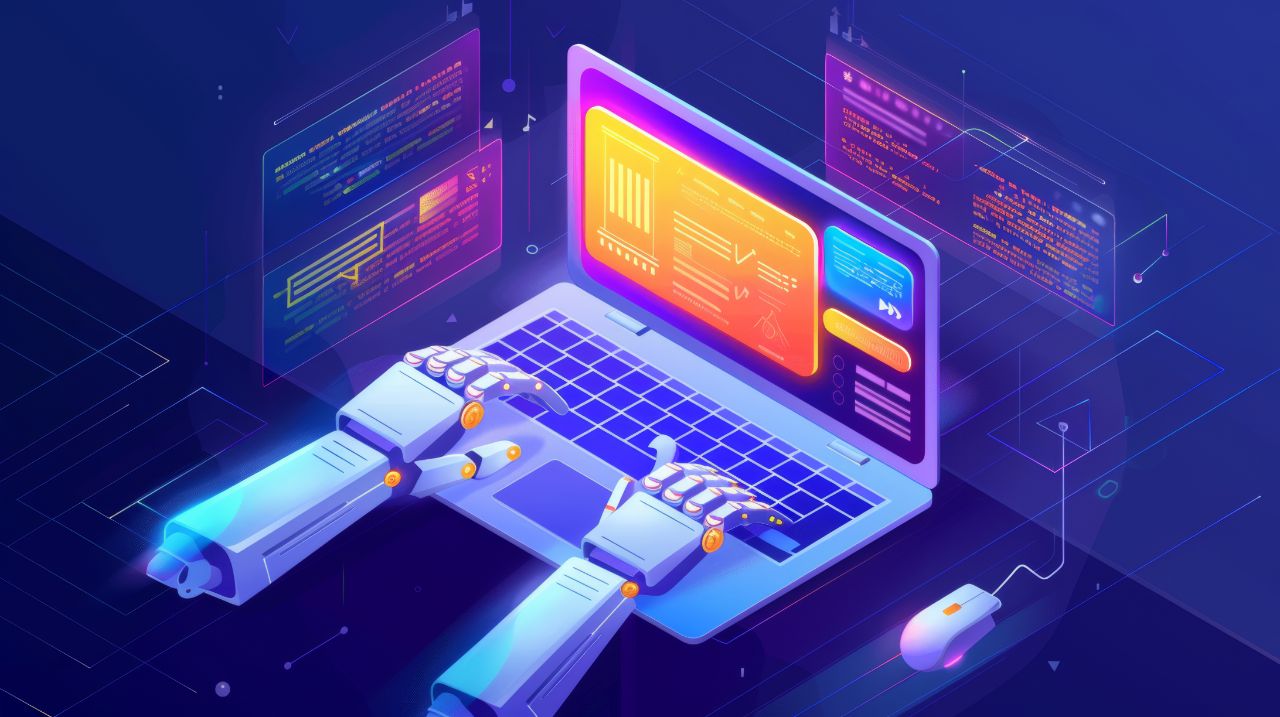In the ever-evolving digital landscape, the fusion of artificial intelligence (AI) and web design has sparked a paradigm shift, propelling the industry towards unprecedented levels of innovation and user-centric experiences. As businesses strive to captivate and retain their online audiences, the integration of AI technologies like generative AI has emerged as a game-changer, revolutionizing the way websites are conceived, developed, and optimized through ai web design and ai website development.
This comprehensive article delves into the profound impact of AI on web design, exploring its far-reaching implications and unveiling the myriad of opportunities it presents for designers, developers, and businesses alike. From streamlining design processes with ai web designer tools to enhancing user experiences and optimizing performance, we will unravel the transformative power of using ai for web design and its pivotal role in shaping the future of digital experiences.
Automating Repetitive Tasks: Unleashing Efficiency
In the realm of web design, AI has proven to be an invaluable ally in automating repetitive tasks, thereby freeing up valuable time and resources for designers and developers to focus on more creative and strategic endeavors. Through the implementation of AI-powered tools and algorithms, tasks such as code optimization, image compression, and content updates across multiple web pages can be streamlined with unprecedented efficiency, improving design efficiency in the web development process.
One notable example is the integration of AI-driven image processing algorithms, which can automatically analyze and optimize images for optimal file size and quality, ensuring faster load times and improved user experiences. Additionally, AI-powered content management systems (CMS) can seamlessly propagate updates across an entire website, eliminating the need for manual intervention and minimizing the risk of human error, enabling automated processes.
Personalized User Experiences: Tailoring Digital Journeys
In today’s highly competitive digital landscape, delivering personalized and engaging user experiences has become a paramount objective for businesses seeking to establish lasting connections with their audiences. Generative AI has emerged as a powerful catalyst in this pursuit, enabling websites to adapt and evolve dynamically based on individual user preferences, behaviors, and demographics to enhance personalization.
Through the implementation of machine learning algorithms and advanced data analytics, AI-driven platforms can analyze vast amounts of user data in real-time, providing valuable insights into user behavior patterns, purchasing habits, and content consumption preferences. Armed with these insights, web designers can create highly tailored user interfaces, content recommendations, and product suggestions that resonate with each visitor’s unique needs and interests, optimizing the overall user experience and customer experience management.
Moreover, AI-powered chatbots and virtual assistants have revolutionized the way users interact with websites, offering personalized support, guidance, and recommendations in real-time. By leveraging natural language processing (NLP) and machine learning techniques, these intelligent systems can understand and respond to user inquiries with human-like accuracy, fostering a more engaging and satisfying digital experience.
Responsive Web Design: Adapting to a Multi-Device World
In the age of mobile-first digital experiences, responsive web design has become a non-negotiable requirement for businesses seeking to cater to users across a multitude of devices and screen sizes. AI has emerged as a powerful ally in this endeavor, enabling the automation of responsive design processes and ensuring seamless compatibility across various platforms through responsive web design tools and alternatives to responsive web design.
Through the implementation of machine learning algorithms, AI-driven tools can analyze user behavior patterns, device specifications, and screen resolutions to dynamically optimize website layouts, ensuring an optimal viewing experience and intuitive navigation regardless of the device being used. This adaptive approach using adaptive layouts not only enhances user satisfaction but also reduces bounce rates and improves overall engagement metrics, leading to more mobile-friendly websites.
Furthermore, AI-powered accessibility features play a crucial role in ensuring that websites are inclusive and accessible to users with varying abilities. By automatically generating alternative text for images, providing screen reader compatibility, and optimizing content readability, AI empowers web designers to create digital experiences that are truly inclusive and accessible to all.
Predictive Analytics: Driving Data-Driven Decisions
In the ever-competitive digital landscape, data-driven decision-making has become a cornerstone of successful web design strategies. AI-powered predictive analytics tools have emerged as invaluable assets in this pursuit, enabling designers and developers to gain deep insights into user behavior, traffic patterns, conversion rates, and other crucial performance metrics for website optimization.
By leveraging advanced machine learning algorithms and big data analysis techniques, these AI-driven tools can process vast amounts of data, identify patterns and trends, and provide actionable insights that inform strategic decision-making. From optimizing website performance and user experiences to refining marketing strategies and content generation, predictive analytics empowers businesses to stay ahead of the curve and deliver truly impactful digital solutions.
Moreover, AI-powered A/B testing tools and experimentation platforms have revolutionized the way designers and developers validate and refine their design choices. By automating the testing process and leveraging machine learning algorithms to analyze results, these platforms enable data-driven optimization, ensuring that design decisions are backed by empirical evidence and user feedback.
Intelligent Design Assistance: Streamlining Workflows
One of the most exciting applications of AI in web design lies in its ability to streamline design workflows and provide intelligent assistance to designers and developers. AI-powered design tools and platforms like ai tool for creating website have emerged, offering a range of innovative features that can significantly enhance efficiency and creativity throughout the design process.
One such example is the integration of AI-driven layout generation algorithms, which can analyze design requirements, user preferences, and industry best practices to generate optimized layout suggestions and provide design recommendations. These intelligent systems can recommend color schemes, typography choices, and visual hierarchies, enabling designers to explore a wide range of possibilities and refine their designs with greater efficiency through layout management.
Additionally, AI-powered design collaboration tools have revolutionized the way teams work together on web design projects. By leveraging machine learning algorithms and natural language processing, these tools can analyze design feedback, automatically identify and resolve conflicts, and streamline the review and approval processes, fostering seamless collaboration and minimizing the risk of miscommunication or delays.
Enhancing Creativity and Innovation
While some may perceive AI as a potential threat to human creativity, the reality is quite the opposite. Generative AI has emerged as a powerful catalyst for innovation and creativity in web design, empowering designers and developers to push the boundaries of what is possible and explore new realms of digital experiences.
By automating repetitive tasks and providing intelligent assistance, AI frees up valuable time and mental resources for designers to focus on more conceptual and creative aspects of their work. This newfound freedom fosters an environment conducive to experimentation, risk-taking, and the exploration of novel design concepts and approaches, enhancing overall design efficiency.
Furthermore, AI-powered generative design tools have opened up new avenues for creative expression. These tools leverage machine learning algorithms to generate unique and innovative design concepts based on user-defined parameters and constraints. By combining human creativity with the computational power of AI, designers can explore a vast array of design possibilities, pushing the boundaries of what is achievable and creating truly groundbreaking digital experiences.
Ethical Considerations and Responsible AI Implementation
As with any transformative technology, the integration of AI in web design raises important ethical considerations that must be addressed to ensure responsible and ethical implementation. One of the primary concerns revolves around the potential for biased algorithms and the perpetuation of societal biases through AI-driven design decisions.
To mitigate these risks, it is imperative for web designers and developers to prioritize transparency, accountability, and ethical oversight throughout the AI implementation process. This includes ensuring that AI systems are trained on diverse and representative datasets, implementing robust bias detection and mitigation strategies, and establishing clear governance frameworks to monitor and audit AI-driven design decisions.
Additionally, data privacy and security must be at the forefront of AI integration in web design. As AI systems rely heavily on user data for training and decision-making, it is crucial to implement robust data protection measures, obtain explicit user consent, and adhere to strict data governance policies to safeguard user privacy and maintain trust.
Upskilling and Adapting to the AI-Driven Future
As AI continues to permeate the web design industry, it is imperative for designers and developers to proactively upskill and adapt to this rapidly evolving landscape. Embracing a mindset of continuous learning and professional development will be essential to staying relevant and competitive in an AI-driven future.
This may involve pursuing specialized training programs, attending workshops and seminars, or engaging in self-paced learning through online courses and resources. By developing a strong understanding of AI technologies, machine learning concepts, and data analysis techniques, web designers and developers can effectively leverage these powerful tools to enhance their workflows, improve design outcomes, and deliver exceptional digital experiences.
Furthermore, collaboration and cross-functional teamwork will become increasingly important as AI integration becomes more widespread. Designers and developers will need to work closely with data scientists, AI experts, and other stakeholders to ensure seamless integration of AI technologies and align design strategies with broader organizational goals and objectives.
Conclusion: Embracing the Future of Web Design
The impact of AI on web design is undeniable, and its transformative potential is vast. As businesses strive to deliver exceptional digital experiences and stay ahead in an increasingly competitive landscape, embracing AI technologies like generative ai website builders has become a strategic imperative.
By harnessing the power of AI, web designers and developers can streamline processes, enhance user experiences, optimize performance, and unlock new realms of creativity and innovation through ai website redesign and web design with ai. However, it is crucial to approach AI integration with a responsible and ethical mindset, prioritizing transparency, accountability, and user privacy.
As we look towards the future, the fusion of AI and web design promises to reshape the digital landscape, ushering in a new era of personalized, adaptive, and intelligent online experiences. Those who embrace this paradigm shift and proactively upskill in web design ai and ai in web development will be well-positioned to thrive in the AI-driven future, delivering cutting-edge digital solutions that captivate and engage audiences on a global scale.
What do you think about this article? #speakyourmind


